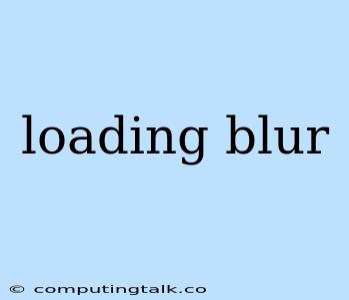Loading screens, those ubiquitous moments of anticipation, can be frustrating if they're not engaging. Imagine staring at a blank white screen for what feels like an eternity, or worse, encountering an uninformative spinning wheel. This is where loading blur comes into play, adding a touch of elegance and visual appeal to your website or app.
What is Loading Blur?
Loading blur is a visual effect that creates a sense of motion and interest during loading times. Instead of presenting a static image or a generic loading icon, loading blur overlays a blurred version of the final image or webpage, giving users a glimpse of what's coming while they wait.
Why Use Loading Blur?
- Enhanced User Experience: Loading blur helps to keep users engaged during loading times, making the experience more enjoyable. It avoids that frustrating feeling of staring at a blank screen.
- Improved Perception of Speed: The visual movement created by loading blur can make loading times feel shorter. This is because the human eye is more drawn to motion, creating a sense of progress.
- Aesthetic Appeal: Loading blur can add a touch of professionalism and sophistication to your website or app, giving it a more polished look.
How to Implement Loading Blur
The implementation of loading blur depends on the specific framework or library you are using. Here are some general guidelines:
- CSS: You can achieve loading blur using CSS properties like
filter: blur(px)to apply a blur effect to the background. You can then gradually reduce the blur as the content loads. - JavaScript: For more complex implementations, JavaScript can be used to control the blur effect, allowing you to dynamically adjust the blur based on loading progress.
- Libraries: There are numerous libraries and frameworks that offer pre-built solutions for loading blur effects, such as:
- React: React libraries like
react-loading-skeletonprovide components for loading blur effects, offering flexibility and customization. - Angular: Angular developers can leverage libraries like
ngx-loading-spinnerfor seamless implementation of loading blur effects.
- React: React libraries like
Tips for Effective Loading Blur
- Maintain Clarity: While loading blur adds visual interest, ensure that the content is still visible. Avoid excessive blur that makes the underlying content unrecognizable.
- Use Gradients: Gradually increasing or decreasing the blur using a gradient effect creates a smoother visual transition.
- Match the Theme: Choose a blur color or style that complements the overall design of your website or app.
- Consider User Accessibility: Ensure loading blur does not negatively impact users with visual impairments.
Examples of Loading Blur
- Websites: Many modern websites, especially those with high-resolution images or complex layouts, utilize loading blur to enhance the loading experience.
- Mobile Apps: Mobile apps frequently use loading blur to create a more seamless and visually appealing loading process.
- Game Interfaces: Even game interfaces sometimes use loading blur to provide a visually engaging transition between loading screens and the main game.
Conclusion
Loading blur is a simple but effective way to improve the user experience by making loading times less tedious. It enhances visual appeal, improves perceived loading speed, and creates a more enjoyable experience for users. By implementing loading blur in your projects, you can make your websites and apps more engaging and visually appealing.
